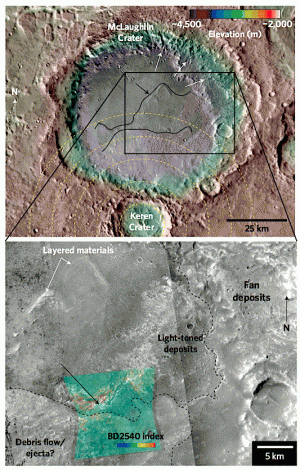Something like half of Earth’s entire biomass lies underground in the form of microorganisms living off geothermal heat and chemicals in the crustal rocks. Could the same hold true for Mars, now or in bygone times? If so, it’s hard to tell because rocks affected by a deep subsurface biosphere remain well out of reach.

WET BASEMENT: GOOD NEWS. In the depths of McLaughlin Crater lie deposits of clays and carbonates that likely formed in the deep subsurface by the action of groundwater. According to new work, these might harbor evidence of a deep subsurface biosphere. (Image taken from Figure 4 in the paper.)
Or do they? Take McLaughlin Crater in northwestern Arabia. It lies on the boundary between the highlands and lowlands, and its floor is well below Martian “sealevel.” The crater has no fluvial channels leading in or out, yet it contains iron- and magnesium-bearing clays and carbonate minerals that resulted from water’s action on the rocks.
A new paper in Nature from a group of scientists led by Joseph Michalski (Planetary Science Institute) proposes that deposits such as those in McLaughlin Crater could preserve evidence of a deep Martian biosphere. They base their argument on what they see as four roughly horizontal zones in the Martian crust. Each is progressively deeper and older, and each has different physical and chemical conditions, which reflect differing environmental histories.
Zone 1 lies at the surface and contains sulfates and layered clays, plus loose sediments and snow, ice, and dust. This zone may make up the top few hundred to thousands of meters in many regions. Zone 2 lies below that, and likely contains brines and chloride deposits. Zone 3 lies 2 to 5 km (1.2 to 3 mi) deep and is likely heavily broken up from ancient giant impacts. Waters in this zone would be neutral to alkaline. Zone 4 lies deeper still and would be rich in hydrothermal activity. But these waters rarely emerge at the surface.
Zones 3 and 4, the team says, offer the best places to look for any subsurface Martian microorganisms. “In the deepest zone,” they note, “the viability of a microbial community is perhaps greater than at similar depths on Earth because a lower gravity implies less compaction of the very limited pore space, and a lower heat flow reduces the temperature constraints.”
McLaughlin Crater is 92 km (57 mi) wide and 2.2 km (1.4 mi) deep relative to its surroundings. As these already lie about 2 km below the planet’s mean radius, the floor of McLaughlin approaches a depth appropriate for Zone 4. “The facts that the crater is deep and situated at a major decline in regional topography suggest that this basin is an excellent candidate in which to search for groundwater activity.”
Data collected by the CRISM spectrometer on the Mars Reconnaissance Orbiter, plus that from the TES instrument on Mars Global Surveyor and THEMIS on Mars Odyssey, have identified deposits of clays and carbonates inside the crater. The team points out that these minerals formed in an environment sharply different from the acidic, water-limited conditions making the sulfate deposits found at much higher elevations in Arabia and elsewhere, including Meridiani Planum.
Inside McLaughlin Crater, channels from the eastern inside wall of the crater end about 500 meters (1,600 feet) above the crater floor. This may indicate a former lake surface, the team writes. Also, the channels end at a broad platform probably made by sediments washing down into standing water. The crater floor contains layered, flat-lying clay-carbonate-bearing rocks, which the scientists interpret as lakebed deposits. These in turn are overlain by lobate flow materials, which suggest the crater floor sediments were buried rapidly.
The team says, “We propose that the materials represent a combination of wet gravity flows and fluidized ejecta emplaced rapidly on the crater floor.” On Earth, they explain, such geometries occur in underwater landslides. “The deposits in McLaughlin Crater could have very high preservation potential for organic materials, in much the same manner as turbidites do on Earth.”
Looking toward the search for Martian life, the scientists argue that the highest priority astrobiological targets on Mars should be portions of deep crust exhumed by impact and erosion. These could preserve evidence of organic chemicals from an era that’s not preserved in Earth’s geologic record.
The team concludes, “Lacustrine clay minerals and carbonates in McLaughlin Crater might be the best evidence for groundwater upwelling activity on Mars, and therefore should be considered a high-priority target for future exploration.”








